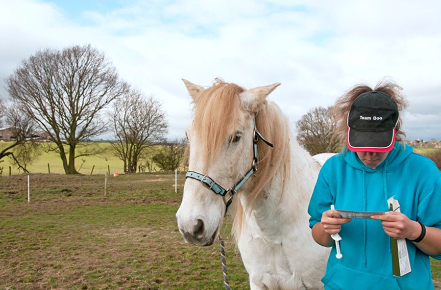It is well known that forages are an essential element of a horse’s diet. They provide the horse with adequate fibre to keep the hind gut of the horse healthy. There have been studies to show that the forage quality can have serious effects on horses’ health and performance. There are many different feeding practices that have been used to counteract poor quality forages. The aim of this experiment is to look at the effects of steaming and soaking hay on the nutrient content, respirable dust concentrations and microbial growth. Good quality and poor-quality hay were used. All hay types went through three treatments; 1) dry (control), 2) steamed for 60mins (in a Haygain™) and 3) soaked hay (submerged in tap water for 10mins). Following treatment nutrient analyses (DM, OM, Ash and CP), bacterial and fungal culture and respirable dust count (0.3, 0.5, 0.7 and 1.0micron at a L/min) was determined.
Analysis of variance and Kruskall-Wallis statistical tests were conducted on the data. The DM content of the poor-quality hay was significantly lower following soaking (42.9% ± 2.15%) compared to the steamed (84.4% ± 3.21%) and dry treatments (89.1% ± 1.13%) (P<0.001). In addition, the DM content of the steamed hay was significantly lower than the dry hay(P><0.05). Treatments had no effect on the Ash, OM, CP (P>0.05). The respirable dust concentrations were significantly lower for the 0.7µm (327,830 ± 42,400 vs 48,485 ± 20,200) and 1.0µm (320,081 ± 42,491 vs 36,387 ±16,696) on the dry compared to soaked (P<0.05). Staphylococcus growth significantly decreased following steaming (1.4 ± 1.9 cfu) compared to soaking (27 ± 47 cfu) (P><0.05). Fungal growth was not affected by treatments (P>0.05).
The DM content of the poor-quality hay was significantly lower following soaking (49.48% ± 3.06%) compared to the steamed (85.39% ± 1.98%) and dry treatments (89.1% ± 1.13%) (P <0.001). Ash content and OM decreased significantly from the dry and steamed compared to the soaked treatment (P><0.05). The treatments had no effect on protein content. The respirable dust concentrations significantly reduced from the dry hay compared to the soaked hay (P><0.05). Yeast growth significantly increased from the dry and steamed hay compared to the soaked hay (P><0.01). Penicillium had the highest growth rates on the dry hay (92%) and steamed hay (98%), yeast was highest on the soaked hay (75%). Steaming had a significant increase in bacillus growth compared to dry treatments and soaked treatment (P><0.05). Soaking had a significant increase in the growth of staphylococcus compared to the dry and steamed treatment (P><0.05).
Good quality-soaked hay had a higher moisture and DM content compared to the poor-quality soaked hay. The respirable dust counts showed a significant difference between the poor-quality dry hay and the good quality dry hay (P><0.01). Good quality hay had a significantly lower respirable dust count for the dry and steamed treatments compared to the poor-quality hay (P><0.05). Aspergillus flavus and bacillus was significantly higher on the poor-quality hay compared to the good quality hay (P><0.05). Yeast growth was significantly higher on the good quality hay compared to the poorquality hay (P><0.001).
Overall, this study highlighted that soaking hay is a good feeding practice for reducing dust, but it will affect the nutrient content of the hay. Steaming is an ideal method to decrease the number of bacteria and fungi in the hay without having a negative effect on the nutrients. The use of any of the treatments in this study will not improve the overall quality of poor hay.
This article was supplied to EquineShow247 by Nicola Boylan





